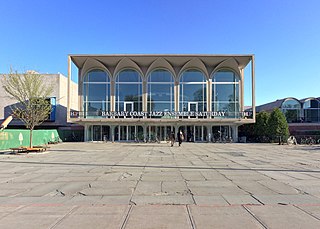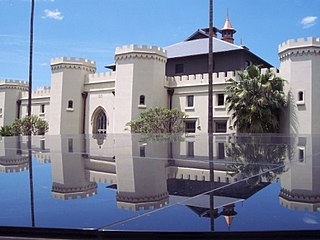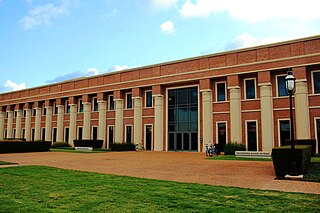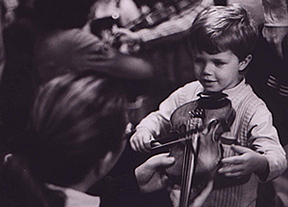The Los Angeles Philharmonic, commonly referred to as the LA Phil, is an American orchestra based in Los Angeles, California. It has a regular season of concerts from October through June at the Walt Disney Concert Hall, and a summer season at the Hollywood Bowl from July through September. Gustavo Dudamel is the current music director, Esa-Pekka Salonen is conductor laureate, Zubin Mehta is conductor emeritus, and Susanna Mälkki is principal guest conductor. John Adams is the orchestra's current composer-in-residence.

The New England Conservatory of Music (NEC) is a private music school in Boston, Massachusetts. It is the oldest continuously operating independent music conservatory in the United States and among the most prestigious in the world. The conservatory is located on Huntington Avenue along the Avenue of the Arts near Boston Symphony Hall, and is home to approximately 750 students pursuing undergraduate and graduate studies, and 1,500 more in its Preparatory School and School of Continuing Education. NEC offers bachelor's degrees in instrumental and vocal classical music performance, contemporary musical arts, composition, jazz studies, music history, and music theory, as well as graduate degrees in collaborative piano, conducting, and musicology. The conservatory has also partnered with Harvard University and Tufts University to create joint double-degree, five-year programs and provide students access to Boston's premier academic resources.

Hopkins Center for the Arts at Dartmouth College is located at 4 East Wheelock Street in Hanover, New Hampshire. The center, which was designed by Wallace Harrison and foreshadows his later design of Manhattan's Lincoln Center, is the college's cultural hub. It is home to the drama and music departments. In addition to these fields, the Hopkins Center, or the "Hop" as it is called by students, has a woodshop and jewelry studio which are open for use by students and the public.

Westminster Choir College (WCC) is a historic conservatory of music currently operating on the campus of Rider University in Lawrenceville, New Jersey. Rider's College of Arts and Sciences, the college under which the historic institution has been reorganized, consists of Westminster Choir College as well as three additional schools.

The University of Michigan School of Music, Theatre & Dance is an undergraduate and graduate institution for the performing arts in the United States. It is part of the University of Michigan at Ann Arbor. The school was founded by Calvin Brainerd Cady in 1880 as the Ann Arbor School of Music, and it was later incorporated into the University of Michigan with Cady joining the faculty.

The Indiana University Jacobs School of Music in Bloomington, Indiana, is a music conservatory established in 1921. Until 2005, it was known as the Indiana University School of Music. It has more than 1,500 students, approximately half of whom are undergraduates, with the second largest enrollment of all music schools accredited by the National Association of Schools of Music.

The Conservatorium High School is a public government-funded co-educational selective and secondary day school with speciality in musical education. It is on the western edge of the Royal Botanic Gardens, off Macquarie Street, in the CBD of Sydney, Australia.
The Henry and Leigh Bienen School of Music is the music and performance arts school of Northwestern University. It is located on Northwestern University's campus in Evanston, Illinois, United States.

The Shepherd School of Music is a music school located on the campus of Rice University in Houston, Texas. From its inception in 1974 under dean Samuel Jones, the Shepherd School has emphasized orchestral, chamber music, and opera as the central elements of its performing curriculum.

The Virginia Glee Club is a men's chorus based at the University of Virginia. It performs both traditional and contemporary vocal works typically in TTBB arrangements. Founded in 1871, the Glee Club is the university's oldest musical organization and one of the oldest all-male collegiate vocal ensembles in the United States. It is currently conducted by Frank Albinder.

The Ann Arbor Symphony Orchestra (A2SO) is an American orchestra based in Ann Arbor, Michigan. It is one of two symphony orchestras in Southeast Michigan alongside the Detroit Symphony Orchestra. Founded in 1928, the A2SO plays most of its concerts at the Michigan Theater and at the University of Michigan's Hill Auditorium.

The Blair School of Music, located in Nashville, Tennessee, provides a conservatory-caliber undergraduate education in music performance, composition, or integrated music studies within the context of a major research university, Vanderbilt University. Blair also provides music lessons, classes and ensembles to over 800 precollege and adult students each semester. Blair is the youngest and smallest of Vanderbilt's ten constituent schools and colleges.

The Notre Dame Symphony Orchestra is the primary orchestra of the University of Notre Dame. The orchestra is an ensemble of 70-80 players devoted to the orchestral music of the 18th through 20th centuries. The orchestra is open to all members of the Notre Dame community; non-music majors who wish to continue instrumental performance during their college careers are particularly encouraged to participate. The orchestra currently rehearses on Tuesday evenings and presents three campus concerts in the Marie DeBartolo Center for the Performing Arts. The orchestra also occasionally takes off-campus tours.
The Conservatory of Music at Wheaton College is a music conservatory located in Wheaton, Illinois. It is both a department and professional school of Wheaton College. It currently has 21 full-time faculty members and approximately 200 undergraduate music majors, and is fully accredited by the National Association of Schools of Music. The Conservatory also operates a Community School of the Arts, serving the music and arts education needs of the surrounding community.
The Don Wright Faculty of Music is the faculty of music at the University of Western Ontario in London, Ontario, Canada. The faculty was founded in 1968. Originally known as just the Faculty of Music, it was renamed in 2002 in honour of Don Wright after a significant donation.

The Princeton Symphony Orchestra is a professional U.S. orchestra based in Princeton, New Jersey. Rossen Milanov has been music director since 2009, leading the orchestra in critically acclaimed performances. All orchestra concerts take place at the 900-seat Richardson Auditorium Richardsonian Romanesque, a historic concert hall located on the campus of Princeton University.
The University of Wisconsin–Madison Mead Witter School of Music is a highly acclaimed collegiate music school consisting of an international roster of faculty artists and scholars devoted to the School's fundamental mission of fostering and promoting the global cultural art of music. It was known as the University of Wisconsin - Madison School of Music until 2016, when the Mead Witter Foundation contributed a $25 million gift to the University, which is being used to fund a planned new performance building. The institution consists of a 60-member faculty that maintains focuses on individual student achievement. The School of Music was established in the year of 1895. The music degree program was organized in 1915, emphasizing training for public school music teachers. In 1939 the School gained acclaimed distinction with the creation of the first musical artist-in-residence position at any American university. The School is housed within the George L. Mosse Humanities building.

Richardson Auditorium in Alexander Hall is a historic 900-seat Richardsonian Romanesque performance hall at Princeton University in Princeton, New Jersey. It is home to both the Princeton University Orchestra and the Princeton Symphony Orchestra.

Youth Orchestra Los Angeles (YOLA) is the Los Angeles Philharmonic's initiative to establish youth orchestra programs in underprivileged communities throughout Los Angeles. Modeled on Venezuela's El Sistema, a program which brings classical music education to children from low-income communities, YOLA provides free instruments, music training, and academic support to nearly 800 students age 6-18. A "social project first and artistic project second", 100% of YOLA's 2016 graduating class completed high school, and 90% went on to college.

The National Youth Orchestra of China is a full symphony youth orchestra composed of approximately 100 Chinese musicians aged 14 to 21 years old. Students from all over China audition to participate in a two-week training residency before performing alongside a renowned soloist and conductor in premier venues throughout the world.
















